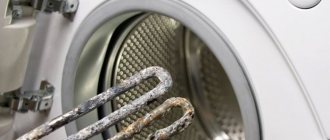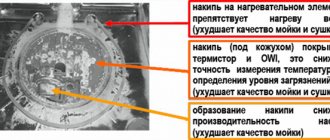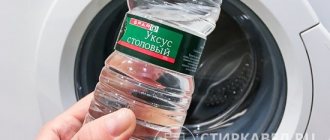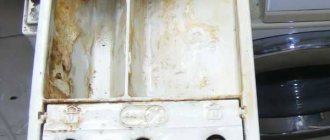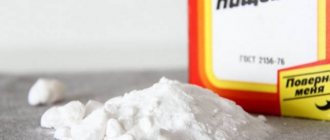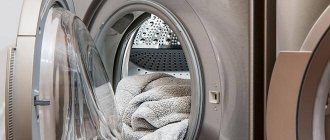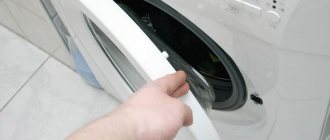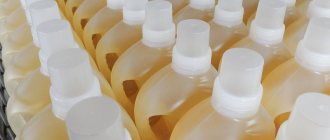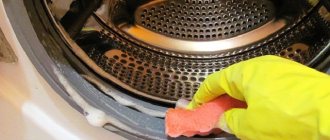/Order/
Regular cleaning of your washing machine not only helps keep it looking its best, but also helps it run efficiently. The fact is that washing machines tend to accumulate:
- Fungus and mold in the sealing gum and, accordingly, the appearance of unpleasant odors;
- Scale on the heating element;
- Residues of powder, rinse aid and other additives inside the machine;
- Dirt and small things in the drain pump filter;
- Rust and sand in the inlet hose filter.
Therefore, over time, you may notice that your clothes (especially light ones) after washing are no longer sparkling clean as they were before. And external dirt that quickly covers the door, countertop and protruding parts of the machine spoils the appearance of the room.
How often do you need to clean your washing machine from scale and dirt? Optimally – once every 2-3 months. If you have a pet at home or you often wash woolen items in a machine, then major cleaning needs to be done more often.
From this material you will learn how to properly clean a washing machine as a whole, namely:
- How to clean the drum of a washing machine, and most importantly, the heating element;
- How to clean the pump in a washing machine (drain filter);
- How to clean the tray and powder receiving compartment;
- How to clean the inlet hose filter;
- How to remove external dirt on the car body and door.
And at the end of the article you will find some tips on prevention and care for your assistant.
See also the material: How to clean a sofa and other upholstered furniture at home.
Causes of unpleasant odor
If you are reading this article, then the topic is relevant to you, which means that one fine day you suddenly discovered that your washing machine is emitting, to put it mildly, an unpleasant odor. At best, it will simply be a damp smell, which is often found in basements. In a more advanced version, it will be a pronounced sewer smell. And then bewilderment sets in, especially if your machine is completely new or you did everything as always. The usual smell of freshness can be replaced by a foreign aroma for several reasons :
- The most common and most basic mistake is closing the hatch immediately after removing the washed items. This is strictly forbidden. The moisture in the drum dries out within a few hours. Only after this time has passed can the lid be closed to prevent it from sagging in the future. Otherwise, you will create more than favorable conditions for the proliferation of various microorganisms or mold - the drum will be warm and damp. Believe me, when in a couple of days you open the hatch, you will simply be horrified, because your device has simply “choked.” And if you wash things without first eliminating the smell, they will also acquire a characteristic aroma;
- Even if some housewives are not lazy and still wipe the drum dry after washing, not all of them pay attention to such a detail as the elastic band along the contour of the hatch . It has a rather complex shape, on which the tightness depends. There are several layers, between which, in addition to water and detergent residues, threads, lint, hair and other objects can remain. In conditions of high humidity, this material is an excellent place for mold to form, which will eventually emit a strange odor. Sometimes it is not even immediately possible to understand why an extraneous odor is present at all if the drum is dry and clean. Therefore, it is better to leave the drum to dry naturally, but carefully wipe the elastic band with a dry soft cloth;
- Another mistake that occurs almost everywhere is storing items to be washed in a drum. And if you close the door at the same time... Remember, dirty things will in any case have a characteristic odor, which will very easily and persistently attach itself inside the drum. Especially if you also block the air supply to things. It’s not for nothing that laundry baskets were invented. They are even produced in different sizes, shapes, colors and designs. Everything so that you can harmoniously fit this attribute into the interior of the bathroom and use it for its intended purpose. All baskets have holes in the walls, lid and bottom, thereby providing ventilation;
- Another reason could be improper installation of the machine . Please note, not connection, but installation. If the appliance is tilted, this may prevent the water from draining completely. As a result, in the corner where there is the smallest slope angle, a small amount of water will remain and stagnate. When exactly musty water makes itself known is only a matter of time;
- If the machine is quite old, the cause of the unpleasant odor may be a clogged drain hose. If a smell appears, it means that so much debris has already accumulated on its walls, on which soap scum, salt, etc. have settled, that it will be much easier and more expedient to replace it than to clean it;
- If you overuse laundry detergent and various conditioners, this can also contribute to the appearance of characteristic odors. Excess product, which simply did not have time to dissolve during washing, sticks to the walls of the machine, the tray for pouring powder, and after some time begins to “smell” actively. And not at all a pleasant aroma of fragrances, as you would like, but rather something rotten. In this case, the rule “more is better” does not work at all. A lack of washing powder will simply result in things not being washed. Therefore, it is best to purchase a measuring spoon or cup and pour in exactly as much powder as the manufacturer recommends in the instructions on the package;
- You should also pay attention to the quality of the products used in washing. Frankly cheap powders may not dissolve well in water. The result will be similar to the point above. Therefore, whenever possible, purchase quality products. In addition, their consumption will be much less, and the washing result will be of higher quality;
- If the tray for loading powder and conditioner is dirty, this can also cause the formation of various odors;
- If the tray is very dirty, then contamination of the channel that is responsible for supplying the detergent is automatically inevitable. Because of this, mold may form, which will smell;
- Another problem area is the drain filter . It is designed to hold various large objects, for example, buttons, pennies, so that they do not clog the sewer. Remaining on the filter, such things gradually begin to become overgrown with soap deposits, to which all sorts of lint strings stick, silt up and begin to stink. It is quite easy to understand whether this is the reason. If the filter is clogged, the water will drain very slowly or stop draining at all;
- If the smell is similar to something rotten or rotten, it means that an impressive layer of dirt has formed on the heating element. If the heating element has scale layer, undissolved detergent particles settle on it very quickly, hair, threads, pet lint or woolen items stick to them. Such a “cocktail” especially makes itself felt if the most familiar washing mode for you is at a temperature of 30-40°C;
- Problems with the sewerage system itself cannot be ruled out. But then, in the event of any accidents or breakdowns, an unpleasant odor will come from both the sink and the bathtub. And if the aroma comes only from the washing machine, perhaps it is not connected correctly - there is no air or water barrier.
As you can see, there are a lot of reasons. Often they are present in a complex. Therefore, the very first step towards identifying the source of the unpleasant odor will be a complete inspection of all elements of the washing machine.
Useful tips
To ensure that your washing machine serves you for a long time and without interruption, use the following tips:
- When washing, use only as much detergent, softener and bleach as you need to wash a specific number of items. Excess laundry detergent will not help make clothes cleaner; it will simply settle inside the unit and lead to breakdowns in the future.
- Before washing, be sure to check the pockets of your items. Take out everything unnecessary so as not to clog the drain filter.
- Do not delay washing if you have already placed a large amount of dirty laundry in the drum.
- Ventilate the drum after each use.
IMPORTANT! Remember to immediately remove items from the drum immediately after washing and send them to dry.
Why does the machine smell like burning?
Sometimes a washing machine can smell not only of dampness, mustiness or rot, but also of burning. This can happen in several cases:
- If the washing machine has just been purchased. Usually, when you first start it, a slight smell, reminiscent of a burning smell, is normal. But it is worth emphasizing that it is light and short-lived. It may appear when plastic parts are heated. And after the second or third turn on it should disappear completely;
- An old machine may also smell like burning, but this is only normal if you replaced the powder with a new one, and it turned out to be not of very high quality, or if shavings of laundry soap were added directly to the drum during washing. This is especially often done by mothers of newborns, arguing that it is safer for the child. There is no point in arguing with this. The smell appears if soap particles get on the heating element and stick to it. In this case, it will emit burning not just during washing, but during the subsequent start-up while heating the soap residues.
If none of the above options are typical for you, or the burning smell does not disappear after running the machine at maximum temperature without idling, be sure to call a technician , because most likely we are talking about the breakdown and melting of some contacts, which can lead to a short circuit.
Call a plumber
Calling a professional technician will help you quickly solve the problem of unpleasant odor from your washing machine.
The plumber will conduct qualified diagnostics and eliminate the problem without any consequences for the further operation of the household appliance.
Removing an unpleasant odor from a washing machine requires a whole range of measures:
- Cleaning and disinfection of the rubber cuff.
- Cleaning the drain pump filters.
- Removing scale from the heating element (if necessary, replace the heating element with a new one).
- Cleaning the powder receptacle, drum, hatch doors of the washing machine.
On average, a set of measures to clean a washing machine will cost 3,000 rubles. It is important to understand that the cost of work may vary. For example, during the cleaning process, the technician diagnoses a breakdown or a worn-out element of a household appliance will need to be replaced.
You can order a plumber's service for cleaning your washing machine on specialized websites for repairing household appliances or by contacting service centers operating near your place of residence.
How is scale formed and why is it dangerous?
Another inevitable problem when operating any device that comes into contact with water is the formation of scale. If you have a boiler with an open or “wet” heating element, then you probably know this phenomenon.
Scale is hard deposits that form on the surfaces of elements that come into direct contact with water and heat it. reasons for the formation of such plaque:
- The most basic is the very poor quality of water, which contains many different impurities and components. In some regions or areas the water may be softer, in others it may be too hard. The water contains magnesium and calcium salts, which are the most harmful to the heating element and the washing machine tank. When water is heated, the salts of these minerals precipitate and form solid deposits;
- In addition to impurities in the water itself, various chemical additives in washing powders also have a detrimental effect;
- Also, scale forms very quickly when the machine is regularly used in the “intensive wash” mode.
to get rid of scale . And it is best to use them in combination. But first of all, you need to evaluate how advisable it is to do this right now. To do this, you need to try to consider the state of the heating element through the holes of the drum. To do this, you need to shine light into the holes and rotate the drum. You will understand in the process how best to do this quickly. If characteristic deposits are visible on the surface, perform two types of cleaning in sequence:
- Mechanical. It is a very effective way. But to do this, you will need to thoroughly study the structure of your device and be able to disassemble it without dire consequences. After you get to the heating element and more clearly appreciate the full scale of the tragedy, you will need to remove the hard coating. It is highly not recommended to use knives, screwdrivers, files and other improvised tools for these purposes that can leave scratches on the surface. It is better to use a sponge with a hard layer, fine-grained sandpaper;
- After this, to remove any remaining scale, soak the heating element in a solution of vinegar or citric acid for several hours, then thoroughly brush with a toothbrush and rinse with clean water. Also, with the help of these two products, you can clean the machine without disassembling it, but more on that a little later. I would also like to clarify exactly what is dangerous about excessive scale accumulation on the heating element:
- The level of heat transfer from the tubes, which are called heating elements, is noticeably reduced due to the build-up of plaque on their surface. This causes the water to heat up more slowly;
- As a result, to achieve the set temperature, the machine needs to work much longer, which naturally entails increased energy consumption;
- The large load that falls on the heating element under such operating conditions will lead to its rapid breakdown and the need for replacement;
- And as we have already found out, scale formation can cause an unpleasant odor.
- An excellent method of preventing scale formation is to install a magnetic filter. This small device is attached to the water supply hose and creates a constant magnetic field. When the machine is filled with water, passing through the formed field, it changes its structure. As a result, impurities are destroyed and do not settle on internal surfaces. The cost of such a device is quite high, however, its service life reaches 50 years, which fully justifies the costs.
The magical effect of Calgon - true or false?
Today, even three-year-old children know by heart the advertisements where the washing machine suffers a bitter fate, and all because the miracle anti-scale remedy was not used on time. Hundreds and thousands of housewives, not wanting this for their favorite washing machine, rushed to the store after watching TV, believing the advertising. Of course, automatic machines cannot be called cheap equipment, and their connection costs a lot of money.
But Calgon is by no means a saving panacea - it is an ordinary water softener, nothing more. Its composition is as follows: soda plus sodium triphosphate (salt of tripolyphosphoric acid Na5P3O10). A package of the product weighing just over half a kilo costs more than $3, which is 3 times more expensive than the cost of the components. By the way, it is quite possible to take these components and make the mixture yourself. It will turn out no worse, but much cheaper. However, you should not rush to do this, nor should you rush to purchase ready-made Calgon.
It turns out that this softener does not serve as a reliable protection for the heating element - on the contrary, it only makes it worse. With constant use of the product, the surface of the tubular electric heater becomes hard, resembling cemented. Where are the scales of magnesium and calcium - this layer is much harder and stronger. As a result, the heating element quickly burns out.
By the way, modern manufacturers certainly add a softener and other substances that care for the machine to good washing powders. And experienced service specialists recommend forgetting about the Calgon product. And if you don’t want your car to wear out prematurely, then don’t listen to the man in the advertisement. By the way, scale prevention can be done much cheaper.
Method 1. Cleaning the washing machine with soda
Before resorting to various types of household chemicals, we suggest trying to eliminate the unpleasant odor associated with the formation of mold using regular baking soda.
- First of all, you need to find where the mold is forming. Perhaps this is the surface of the drum itself, the tray for loading powder, or the surface of the rubber seal;
- First, let's prepare a soda-based paste. To do this, mix 0.5 cups of soda and 0.5 cups of water.
- Mix thoroughly until a paste-like consistency is formed;
- Be sure to wear rubber gloves;
- Apply a little paste to a sponge and rub the affected surface well;
- After this, you need to rinse off the paste and turn on the machine to rinse mode.
Using a mixture of baking soda and citric acid, you can try to remove scale from the internal surfaces of the machine. For this:
- Mix 150 g of citric acid and 2-4 teaspoons of baking soda;
- The mixture must be poured into the tray for loading washing powder;
- Turn on the machine to wash mode at the highest temperature, and after finishing, run an additional rinse cycle.
- Naturally, you need to pour any machine cleaning product into a pre-washed tray. Also note that the drum must be empty. If for some reason you don’t like the machine to run idle, throw in a floor rag or an old towel. In general, something that you wouldn’t mind throwing away if the color changes.
Method 2. Wash the machine with citric acid
Using citric acid you can also eliminate the unpleasant odor associated with the formation of scale. The secret is that expensive products that are designed to remove plaque are almost 75% acid. So why pay more?
- Pour 50-100 g of lemon into the powder loading tray;
- Select the longest wash cycle at the highest temperature;
- After finishing washing, run an additional rinse.
I came across a large number of reviews on various forums that said that after cleaning the machine with citric acid, the smell not only did not go away, but also intensified. I'll explain why this happens:
- Apparently, your machine is more than one year old and during its operation a large amount of scale and various contaminants have managed to settle on the surface of its heating element;
- Plus, most likely, in order to reduce washing time and save energy, you most often washed at temperatures no more than 40°C;
- After you ran your machine, firstly, at maximum temperature, and, secondly, with the addition of acid, which breaks down scale and other sediment, they simply could not dissolve completely;
- After you turn on the machine again after a few days, as the water heats up, the remaining scale and dirt also heats up and begins to re-emit an unpleasant odor.
- Therefore, you simply did not clean the machine. Just repeat the procedure and see how the smell disappears completely. You need to use citric acid, and not lemon juice, the concentration of which is much lower.
Despite all the advantages and effectiveness of this method, it is highly not recommended to use it more than once every 6 months and use more acid. There are many diametrically opposed opinions expressed online regarding this method of cleaning a washing machine, from 100% favorable to completely negative. It is likely that such a radical difference in the opinions of readers is associated with the operation of equipment from different manufacturers, produced in different time periods using different materials.
Preparation
Before carrying out the procedure, carefully read the operating instructions for the device and consider which product will be optimal for use in your particular machine model.
Precautionary measures
Special cleaning products should be used with extreme caution and strictly adhere to the dosage recommended by the manufacturers. Otherwise, the product may damage the metal, rubber or plastic elements of the device.
The same rule applies to cleaning the device using traditional methods . So, for example, when using citric acid, it is unacceptable to start the unit at a temperature of more than 80 ⁰C or fill the receiving tray with a large amount of product.
Method 3. Vinegar as a preventative measure
Using regular 9% vinegar, you can get rid of such troubles as fungus or mold .
- The tray for loading washing powder should also have a compartment for pouring liquid powder. This is where you need to pour 2 cups of vinegar;
- Select a high temperature wash program and start the machine;
- After the machine has worked for 10-15 minutes, you need to press pause and leave it in this state for an hour or two;
- This is necessary so that the vinegar solution has time to have the proper effect on microorganisms and, possibly, dissolve a thin layer of scale;
- After this, resume washing and let the “wash” mode finish;
- An additional rinse completes the cleaning;
- After this, open the machine, take a clean cloth soaked in a vinegar solution, and thoroughly wipe the rubber seal and inspect it for debris;
- Leave the door open to dry the drum and wipe the rubber with a dry cloth.
Keep in mind that cleaning with vinegar is accompanied by a characteristic odor.
By the way, some housewives add vinegar directly during washing. Literally 1-2 tablespoons. It acts as a water softener, thereby preventing scale formation. And if you add apple cider vinegar, the laundry itself will acquire a barely noticeable, light and pleasant aroma.
Method 4. Chlorine for cleaning a washing machine
Also in the vast expanses of boarding schools you can find many conflicting reviews about whether chlorine can be used as a cleaner, does it corrode rubber elements? It's possible, if you don't abuse it. fight mold and disinfect hard-to-reach places in your washing machine using regular whitewash:
- Pour 100 ml of white into the drum;
- Turn on the wash cycle at high temperature;
- It will take about 30-40 minutes to destroy microorganisms;
- After this, turn on an additional rinse.
It is recommended to clean with a chlorine-containing product no more than once every 6 months. Also be careful when using Domestos instead of white. Keep in mind that it tends to foam.
Method 5. The best ready-made remedies
If folk remedies do not inspire confidence in you, at any household chemical store, you can purchase a ready-made product either for disinfection or for removing scale. The most effective of them:
- Detergent for German washing machines. It is produced in the form of a liquid, which, according to consumers, is very effective and helps to dissolve even an impressively thick layer of scale;
- Another German liquid product, Topperr 3004, is sold in 250 ml bottles and is designed for two cleanings;
- A universal product that is intended for cleaning not only washing machines, but also electric kettles, irons, dishwashers and other household appliances, “Luxus Professional”. It has a lemon scent and is sold in 500 ml bottles. There is enough liquid for 4 full cleanings;
- The concentrated Korean remedy is available in powder form. There are only 4 sachets in the package, respectively, for 4 cleanings. Before use, the powder is dissolved in water, the amount of which is indicated on the package;
- The Japanese product “Kaneyo” is also in demand. It not only removes scale, but also has an antibacterial effect. Sold in bottles and containing chlorine.
Method 6. Clean individual elements of the washing machine
We've told you exactly what means you can use to clean your machine, now we'll tell you how to get to the most problematic areas. To remove and thoroughly wash powder loading tray
- Understand how the tray is attached. It is usually held in place by side latches. Most often, it is enough to press the latches and pull the compartment towards you, lifting it up a little. Some models have a button on the side that must be held to release the fastenings;
- When you have the compartment in your hands, first rinse it well under hot water;
- Using a toothbrush, carefully remove any remaining detergent from all possible grooves;
- If the plaque is very persistent and there are traces of mold, use a solution of citric acid, soda or bleach;
- Also inspect the place where the tray is inserted, perhaps there are powder residues there too.
The problem area, where all sorts of debris most often accumulates and mold forms, is the rubber seal along the contour of the hatch.
- It is most convenient to wash it immediately after washing, when it is still damp;
- For convenience, stock up on ear sticks or tissue;
- The fabric must be wrapped around your finger and carefully reached into all the folds;
- For cleaning, use vinegar, which will not only help get rid of microorganisms, but also eliminate the odor. You can also use a solution of bleach and water in a 1:1 ratio;
After you have used one of the descaling methods, it is very likely that some scale particles remain in the drain filter . And not only them, but also all sorts of small objects that can fall into the machine if you do not check the contents of the pockets before washing. To clean it you need:
- Find where the filter itself is located. Usually there is a plastic cover or plug on the front of the machine body, in the lower right or left corner;
- It must be carefully picked out and removed;
- Be prepared for the fact that after removing the lid, residual water may leak out - spread a rag;
- If the water no longer flows, you can pull out the plug;
- All debris must be removed and the filter rinsed under running water. Use detergents if necessary.
the drain hose should also be cleaned , but if this was not enough, you will have to clean it separately:
- Unplug the washing machine and turn off the water supply;
- Place a low container under the hose attachment point, then unscrew it;
- Inspect the interior surface. If everything looks scary, try cleaning the cavity with a cable with a soft brush attached to the end;
- If cleaning does not produce results, it is better to replace the hose with a new one.
Care instructions
Periodic cleaning of the drum is just one link in a whole chain of unit care procedures.
IMPORTANT! This element of the device can be called a kind of indicator, which is convenient for determining whether other parts of the machine need cleaning.
Look into the drum and inspect it carefully - if there are traces of scale or dirty deposits on the walls, then the internal parts of the device will be in even worse condition, and cleaning should be started immediately.
Learn more about how to clean elastic in the washing machine.
In addition to the drum, the following parts require regular maintenance:
- drainage system (filter and hose);
- water supply system to the unit (inlet filter, hose);
- rubber seal located between the device door and the drum;
- heating element.
Method 7. How to clean a top-loading machine?
Top-loading machines are more difficult to maintain; they have more hard-to-reach places, so we will clean them using various compounds:
- We need a wash cycle at the highest temperature;
- Add 2-3 cups of vinegar to the water, after a few minutes add another 0.5 cup of baking soda.
- The reaction will begin;
- Stop the machine and leave for 0.5-1 hour with the solution inside;
- At this time, using a vinegar solution, thoroughly wash the powder loading tray and the outside of the machine;
- Resume the washing process. Once completed, drain the water and look inside. If there is dirt, remove it with a sponge.
The article was written for the site.
Tags:Bathroom, Cleaning

